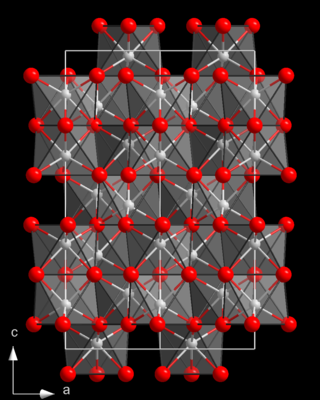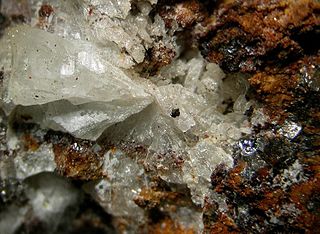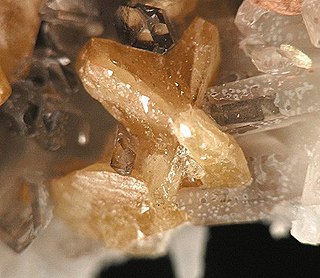
Tephroite is the manganese endmember of the olivine group of nesosilicate minerals with the formula Mn2SiO4. A solid solution series exists between tephroite and its analogues, the group endmembers fayalite and forsterite. Divalent iron or magnesium may readily replace manganese in the olivine crystal structure.

Cerite is a complex silicate mineral group containing cerium, formula (Ce,La,Ca)
9(Mg,Fe3+
)(SiO
4)
6(SiO
3OH)(OH)
3. The cerium and lanthanum content varies with the Ce rich species and the La rich species. Analysis of a sample from the Mountain Pass carbonatite gave 35.05% Ce
2O
3 and 30.04% La
2O
3.

Melilite refers to a mineral of the melilite group. Minerals of the group are solid solutions of several endmembers, the most important of which are gehlenite and åkermanite. A generalized formula for common melilite is (Ca,Na)2(Al,Mg,Fe2+)[(Al,Si)SiO7]. Discovered in 1793 near Rome, it has a yellowish, greenish-brown color. The name derives from the Greek words meli (μέλι) "honey" and lithos (λίθους) "stone".The name refers to a group of minerals (melilite group) with chemically similar composition, nearly always minerals in åkermanite-gehlenite series.

Titanium(III) oxide is the inorganic compound with the formula Ti2O3. A black semiconducting solid, it is prepared by reducing titanium dioxide with titanium metal at 1600 °C.

Mullite or porcelainite is a rare silicate mineral formed during contact metamorphism of clay minerals. It can form two stoichiometric forms: 3Al2O32SiO2 or 2Al2O3 SiO2. Unusually, mullite has no charge-balancing cations present. As a result, there are three different aluminium sites: two distorted tetrahedral and one octahedral.

Heazlewoodite, Ni3S2, is a rare sulfur-poor nickel sulfide mineral found in serpentinitized dunite. It occurs as disseminations and masses of opaque, metallic light bronze to brassy yellow grains which crystallize in the trigonal crystal system. It has a hardness of 4, a specific gravity of 5.82. Heazlewoodite was first described in 1896 from Heazlewood, Tasmania, Australia.
Allabogdanite is a very rare phosphide mineral with the chemical formula (Fe,Ni)2P, found in 1994 in a meteorite. It was described for an occurrence in the Onello meteorite in the Onello River basin, Sakha Republic; Yakutia, Russia; associated with taenite, schreibersite, kamacite, graphite and awaruite. It was named for Russian geologist Alla Bogdanova.
Altisite (IMA symbol: Ati) is an exceedingly rare alkaline titanium aluminosilicate chloride mineral with formula Na3K6Ti2Al2Si8O26Cl3, from alkaline pegmatites. It is named after its composition (ALuminium, TItanium, and SIlicon).

Fluellite is a mineral with the chemical formula Al2(PO4)F2(OH)•7H2O. The name is from its chemical composition, being a fluate of alumine (French).
Panguite is a type of titanium oxide mineral first discovered as an inclusion within the Allende meteorite, and first described in 2012.
Kangite is an exceedingly rare scandium mineral, a natural form of impure scandium oxide (Sc2O3), with the formula (Sc,Ti,Al,Zr,Mg,Ca,□)2O3. It crystallizes in the cubic crystal system diploidal class. In terms of chemistry it scandium-analogue of tistarite. Both kangite and tistarite were discovered in the Allende meteorite.

Ferrokentbrooksite is a moderately rare mineral of the eudialyte group, with formula Na15Ca6(Fe,Mn)3Zr3NbSi25O73(O,OH,H2O)3(Cl,F,OH)2. The original formula was extended form to show the presence of cyclic silicate groups and presence of silicon at the M4 site, according to the nomenclature of eudialyte group. As suggested by its name, it is the (ferrous) iron analogue of kentbrooksite. When compared to the latter, it is also chlorine-dominant instead of being fluorine-dominant. The original (holotype) material is also relatively enriched in rare earth elements, including cerium and yttrium.
Johnsenite-(Ce) is a very rare mineral of the eudialyte group, with the chemical formula Na12(Ce,La,Sr,Ca,[ ])3Ca6Mn3Zr3WSi(Si9O27)2(Si3O9)2(CO3)O(OH,Cl)2. The original formula was extended to show the presence of both the cyclic silicate groups and silicon at the M4 site, according to the nomenclature of the eudialyte group. It is the third eudialyte-group mineral with essential tungsten, and second with essential rare earth elements. In fact, some niobium substitutes for tungsten in johnsenite-(Ce). Other characteristic feature is the presence of essential carbonate group, shared with carbokentbrooksite, golyshevite, mogovidite and zirsilite-(Ce).

Khomyakovite is an exceedingly rare mineral of the eudialyte group, with formula Na12Sr3Ca6Fe3Zr3W(Si25O73)(O,OH,H2O)3(OH,Cl)2. The original formula was extended to show the presence of both the cyclic silicate groups and M4-site silicon, according to the nomenclature of the eudialyte group. Some niobium substitutes for tungsten in khomyakovite. Khomyakovite is an iron-analogue of manganokhomyakovite, the second mineral being a bit more common. The two minerals are the only group representatives, beside taseqite, with species-defining strontium, although many other members display strontium diadochy. Khomyakovite is the third eudialyte-group mineral with essential tungsten.
Davisite is an exceedingly rare mineral of the pyroxene group, with formula CaScAlSiO6. It is the scandium-dominant member. It stands for scandium-analogue of other pyroxene-group members, esseneite, grossmanite and kushiroite. Davisite is one of scarce minerals containing essential scandium.
Grossmanite is a very rare mineral of the pyroxene group, with formula CaTi3+AlSiO6. It is the titanium-dominant member. Grossmanite is unique in being a mineral with trivalent titanium, a feature shared with tistarite, Ti2O3. Titanium in minerals is almost exclusively tetravalent. Grossmanite stands for titanium-analogue of davisite, esseneite and kushiroite – other members of the pyroxene group. Both grossmanite and tistarite come from the famous Allende meteorite.
Yttriaite-(Y) is an exceedingly rare mineral, a natural form of yttrium oxide, Y2O3. In terms of chemistry it is yttrium-analogue of kangite, arsenolite, avicennite and senarmontite (isometric minerals). Other minerals with the general formula A2O3 include corundum, bismite, bixbyite, eskolaite, hematite, karelianite, sphaerobismoite, tistarite, and valentinite. Yttriaite-(Y) forms tiny inclusions in native tungsten.

Monazite-(Ce) is the most common representative of the monazite group. It is the cerium-dominant analogue of monazite-(La), monazite-(Nd), and monazite-(Sm). It is also the phosphorus analogue of gasparite-(Ce). The group contains simple rare earth phosphate minerals with the general formula of AXO4, where A = Ce, La, Nd, or Sm (or, rarely, Bi), and X = P or, rarely, As. The A site may also bear Ca and Th.
Monazite-(La) is a relatively rare representative of the monazite group, with lanthanum being the dominant rare earth element in its structure. As such, it is the lanthanum analogue of monazite-(Ce), monazite-(Nd), and monazite-(Sm). It is also the phosphorus analogue of gasparite-(La). The group contains simple rare earth phosphate minerals with the general formula of ATO4, where A = Ce, La, Nd, or Sm (or, rarely, Bi), and B = P or, rarely, As. The A site may also bear Ca and Th.
Monazite-(Nd) is a relatively rare representative of the monazite group, with neodymium being the dominant rare earth element in its structure. This variety of monazite is typically colored bright rose-red. It is the neodymium analogue of monazite-(Ce), monazite-(La), and monazite-(Sm). The group contains simple rare earth phosphate minerals with the general formula of ATO4, where A = Ce, La, Nd, or Sm (or, rarely, Bi), and B = P or, rarely, As. The A site may also bear Ca and Th.










